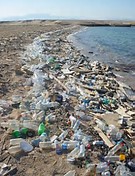 Wikipedia photo
Wikipedia photo
The International Organization for Migration (IOM) held a “side event” on June 6, 2017 during the “first-ever” United Nations Ocean Conference. This side event’s topic was “Ocean Health, Climate Change and Migration: Understanding the Nexus and Implications for People on the Move.”
The World Wildlife Fund (WWF), the Permanent Mission of Madagascar and Ecuador partnered with IOM to promote the implementation of Sustainable Development, Goal #14 of U.N.’s Agenda 2030, “to conserve and sustainably use the oceans, seas and marine resources for sustainable development.” https://www.iom.int/news/iom-highlights-ocean-health-climate-change-migration-inaugural-un-ocean-conference
The idea of all these U.N. sponsored conferences around the globe is that, if the United Nations is in control and is the ultimate decision-maker, all the goals of the Agenda 2030 can be easily implemented and the wealth redistributed to all third world nations while protecting Mother Earth from hysterical Armageddon.
The Permanent Mission of Fiji noted that “the ocean is part of everyday life in Fiji – they are not only linked to livelihoods but are also an integral part of our cultural heritage.”
The event was moderated by Rosiland Jordan, U.N. Correspondent for Al Jazeera, and the audience was composed of “member state representatives, civil society, academics, scientists, journalists, and NGOs.”
Presentations were made by John Tanzer (WWF), Jean Randriannatenaina (Regional Maritime Information Fusion Center, Madagascar), Francoise Gail (Scientific Advisor, Ocean and Climate Platform), and Mariam Chazalnoel (IOM) on “direct consequences that climate change-related modification to the global ocean have on island and coastal populations as the environment, economy and livelihoods of many of these communities depend on oceans” and examples were given of changes that influence the “migration patterns of affected communities as well as the daily lives of communities receiving migrants.”
Ashraf El Nour, Director to the IOM Office of the U.N., discussed displacement of communities and the impact on human settlements located near or who depend on the world’s oceans for their survival. According to the Internal Displacement Monitoring Center, 24.2 million people were displaced in 2016 due to natural disasters in the world, mainly floods and storms, clearly weather events, claiming that “many of them were made worse by the climate change impacts in oceans’ coastal areas.”
We do know that such claims of global warming/anthropogenic climate change effects are false and were debunked by scientific data, many studies that contradict U.N.’s IPCC computer modeling and fear-mongering.
This IOM side-event also noted that “slow environmental degradation in coastal areas, such as sea level rise or coastal erosion, are also expected to have long-term impact on migration, as people move preemptively to find alternative livelihoods or are forced to relocate inland.”
The topics discussed were specifically chosen to harmonize with the Partnership Dialogues of the Ocean Conference which must support Agenda 2030’s Goal 14:
– Managing, protecting and conserving marine and coastal ecosystems (PD2)
– Ocean acidification (PD 3)
– Making fisheries sustainable (PD 4)
– Increasing economic benefits to small islands developing states and least developed countries (PD 5) – more wealth redistribution schemes
There are many stakeholders in this environmental fear
mongering. Additionally, the Ocean Conference was promoted as an opportunity to push migration and oceans in preparation for the COP23 climate change/fossil fuels negotiations in Bonn, Germany, in November 2017.
Instead of vilifying the gas of plant life, carbon dioxide (CO2), the discussion should have focused on the garbage pollution of the world’s oceans by the top eight countries in Asia, China, Indonesia, the Philippines, Vietnam, Sri Lanka, Thailand, Malaysia, and Bangladesh.
Millions of tons of plastic trash float into the world’s oceans yearly. A 2015 study published in the Science journal found that “Population size and the quality of waste management systems largely determine which countries contribute the greatest mass of uncaptured waste available to become plastic marine debris. Without waste management infrastructure improvements, the cumulative quantity of plastic waste available to enter the ocean from land is predicted to increase by an order of magnitude by 2025. http://science.sciencemag.org/content/347/6223/768
China, for example, with its heavily coastal population, dumps approximately 1.3 million to 3.5 million metric tons of plastic into the oceans per year, mostly because of its mismanaged waste. According to the study, if the top 20 countries would cut their mismanaged waste by half, the mass of floating plastic would drop by 41 percent.
Sea mammals, fish, and even smaller invertebrates can gulp pieces of plastic or become entangled in fishing nets or plastic debris. Eventually some of the broken plastic trash sinks to the bottom.
“Quantifying the precise amount that ultimately washes out to sea is problematic, though, since there is a dearth of reliable data.”
“Few of the top contributing countries have adequate infrastructure for handling trash disposal, the study authors noted. Even with a well-developed infrastructure to handle solid waste, the U.S. contributed 40,000 to 110,000 metric tons per year, and ranked 20th, they found.” http://www.latimes.com/science/sciencenow/la-sci-sn-tons-of-plastic-trash-in-oceans-20150213-story.html
ILEANA JOHNSON
American By Choice
